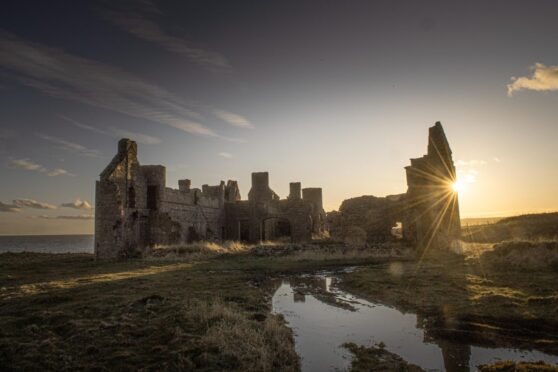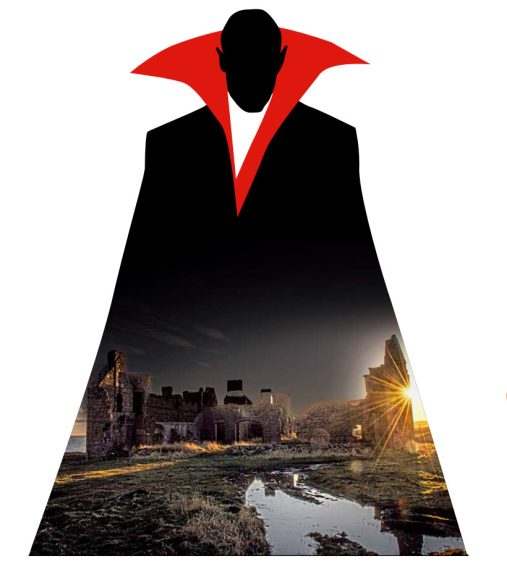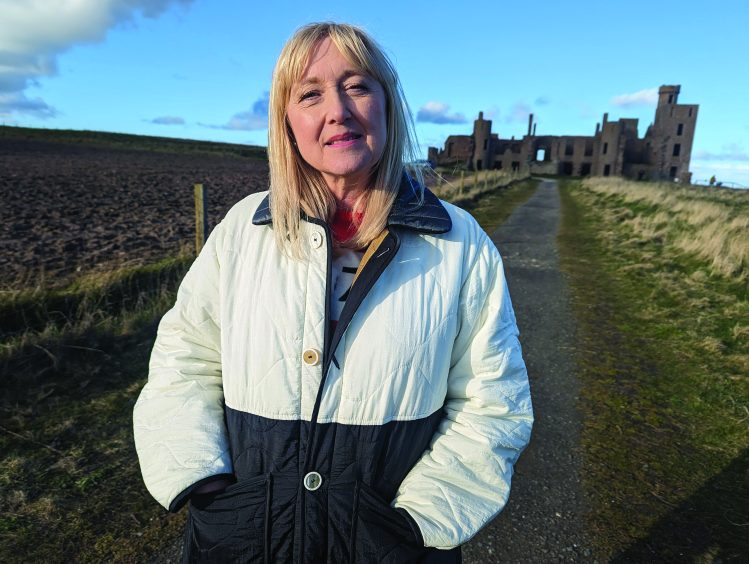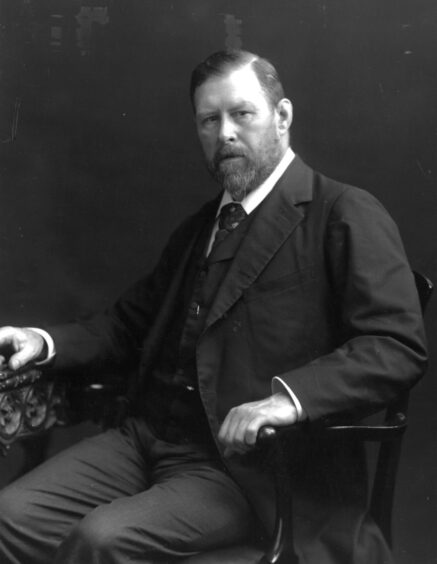
A ruined castle perches like a bird of prey on a jagged mountain as a luminous full moon watches quietly from an inky black sky.
A dark atmosphere sets in as thick as the fog rolling down from the rugged hills, and a place that seems harmless and beautiful during the daytime becomes unsettlingly sinister.
Is this Dracula’s Castle in Transylvania, or Slains Castle in Aberdeenshire? Or are they both one and the same?
A new documentary is trying to work that out. Sàr-sgeòil, a BBC Alba series presented by Cathy MacDonald, explores Scotland’s influence on works of classic literature such as George Orwell’s 1984 and Mary Shelley’s Frankenstein. This Halloween, Cathy and Sàr-sgeòil will explore what is possibly Scotland’s spookiest literary connection – Bram Stoker’s gothic horror Dracula.
“Like many people, my knowledge of Dracula is what I had seen on the screen,” said Cathy. “I came to it knowing very little about how the book came about or its relationship with Scotland.”
Dracula was first published in 1897 and has held a vampiric omnipresence over the horror genre ever since. What is less well known is that Bram Stoker wrote most, if not all, of his famous novel in the tiny coastal village of Cruden Bay in Aberdeenshire.
Cathy said: “When we visited Cruden Bay for the documentary, you can see how someone with Bram Stoker’s imagination could be completely inspired by the area. The crashing of waves, the dramatic cliffs. Some areas have such a strong sense of place and following Stoker’s footsteps reinforced the atmosphere that the book inspires.
“Cruden Bay is also quite beautiful, so you can see how he needed that calmness to work out the plot and create characters. There’s a wonderful contrast between the frightening and the beautiful there.”
One sharp area of contrast in Cruden Bay is Slains Castle. The ruin sits on a rocky cliff face overlooking the North Sea, and during the daytime, it looks pretty harmless. When night falls, however, the spookiness sets in.
Cathy said: “In the daytime, it’s quite benign. It’s beautiful, but it’s also remote – and the coastline is quite threatening. When the sun sets, you get that sense of fear and horror.”
While many buildings have been cited as the inspiration for Dracula’s Castle, Slains has perhaps the strongest claim. Its floorplan often matches the layout of Dracula’s Castle, and its distinctive octagonal hall is almost exactly like the one described by Stoker when protagonist Jonathan Baker first arrives at Dracula’s abode.
Despite the fantastical elements of his book, Stoker’s inspiration often came from what he saw around him.
Inspiration also came from what he read, too. Emily Gerard, a Scottish woman born in 1849, was known in the late 19th Century for her travel writing, particularly her work on Transylvania and Transylvanian folklore and customs. It was her work that gave Stoker much of the vampire myths and superstitions that formed the bedrock of his Dracula story.
Cathy explained: “Her husband was a soldier and posted to Transylvania in the 1880s. She met and spoke with the local people, and felt it was important to write their stories and folklore down. And it seems Stoker was familiar with her work, and reading her writing might have been that spark that led to Dracula. I think her story has been overlooked, she was completely new to me. She was an incredibly interesting woman.”
Gerard was not the only person Stoker consulted on folklore. He would also visit the Cruden Bay fishermen and ask them about local stories and superstitions.
Cathy said: “Folklore is incredibly important because they are our earliest stories, they give us our social history. I think what Bram Stoker and Emily Gerard did was go back to those original stories.
“These authors have a huge understanding and encyclopaedic knowledge of tales and traditions, of the communities about which they were writing. It’s what you do with those stories that test your originality and imaginative powers. His work isn’t completely made up, it springs from original customs and traditions – that certainly comes through in his work.”

Scotland’s wild landscape and its superstitious people might have been an inspiration for Stoker, but in time his monstrous creation would influence Scottish folklore right back.
By the time the 1950s rolled around, Bela Lugosi had already slicked back his hair and donned his billowing cape and fake fangs. Dracula-knockoff Nosferatu’s shadowy figure lived long in the minds of movie buffs everywhere. Thanks to Bram Stoker, vampires were no longer obscure figures of folklore, but darkly glittering pop culture stars in their own right.
Should it have been so much of a surprise then, when a rumour about a 7ft vampire prowling the playgrounds of Glasgow grew out of control in the autumn of 1954?
Convinced they were being hunted by the undead, the children of the Gorbals refused to take it lying down. They armed themselves with crosses, stakes, blades and dogs and descended on the Southern Necropolis to smoke the beast out. They never found him, but the Gorbals Vampire has been a legend ever since.
Cathy said: “Horror can be really infectious. Dracula has such an ability to affect people, it seems inevitable something like that would happen! The book has great power. Dracula is absolutely one of the most important books in our literary canon.”
Haunting hotspots
As Halloween approaches, it seems the best place to spot something spooky is in Scotland’s rural areas.
A new survey by games provider Lucky Streak, based on reports submitted to The Paranormal Database and population data via Total Population, discovered Orkney is Scotland’s hauntings hotspot, with 42 reported incidents among just 22,724 people. That means an Orcadian would be 267 times more likely to experience a spooky event than to match five numbers on the lottery.
Next is the Outer Hebrides, then Shetland, Argyll & Bute and the Highlands, which has the most reported hauntings with 235.
The only cities in the top 10 are Stirling and Perth, while Glasgow is ranked as the least likely place in the country to experience a ghostly encounter.
Sàr-sgeòil: Dracula, BBC Alba, Thursday, 9pm

Enjoy the convenience of having The Sunday Post delivered as a digital ePaper straight to your smartphone, tablet or computer.
Subscribe for only £5.49 a month and enjoy all the benefits of the printed paper as a digital replica.
Subscribe
